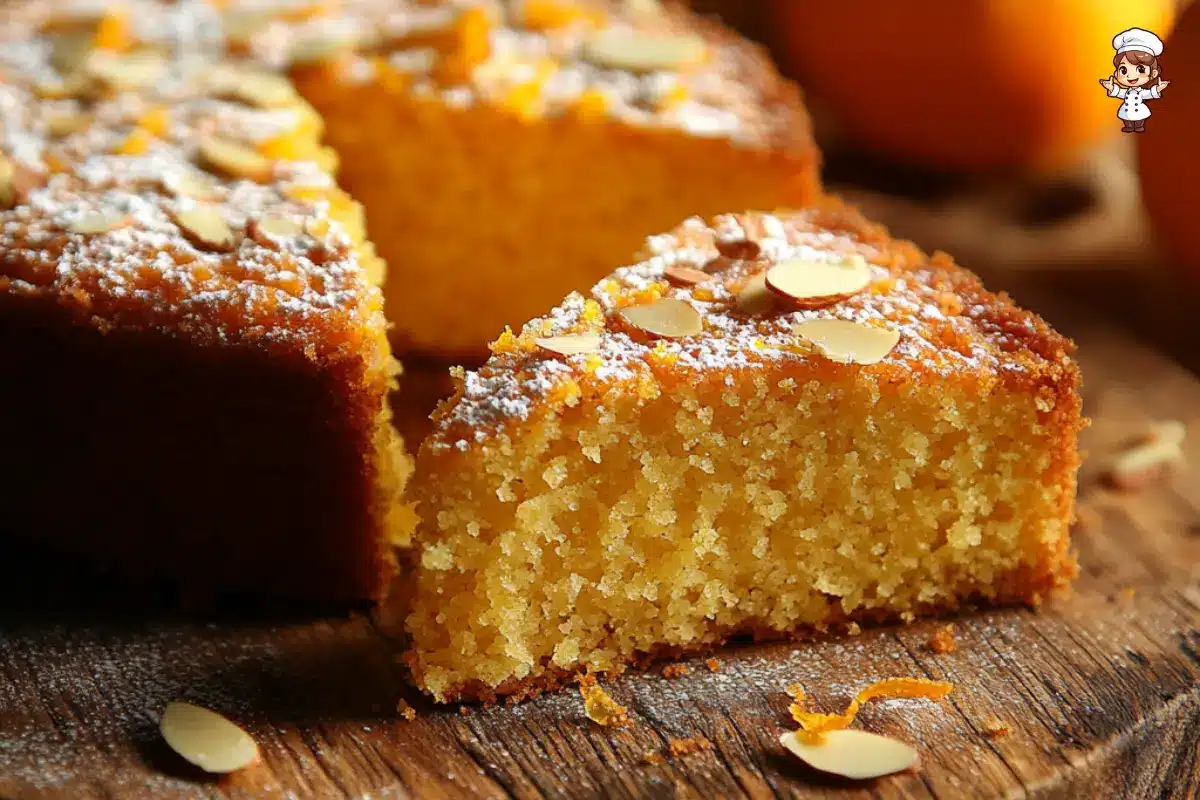If you’re looking for a fluffy and moist cake with a refreshing citrus twist, the Orange Semolina Cake is your answer. This delightful dessert blends the nutty flavour of semolina with the bright, zesty taste of fresh oranges. Whether you’re baking for a special occasion or simply craving something sweet, this cake is a perfect choice.
In this article, we’ll dive deep into the world of Orange Semolina Cake. We’ll explore what makes this cake unique and its key ingredients and provide a step-by-step guide to creating it at home. Plus, we’ll offer tips for variations, troubleshooting, and storing your cake, ensuring you have all the knowledge to make this dessert a success every time.
Introduction to Orange Semolina Cake
What is Orange Semolina Cake?
The Orange Semolina Cake is a simple yet flavorful cake that combines the delicate texture of semolina with the tangy sweetness of oranges. Semolina, a flour made from durum wheat, lends a slightly grainy texture to the cake, contrasting beautifully with the soft, moist crumb. The addition of fresh orange juice and zest brings a burst of citrus flavour, making each bite feel like a little taste of sunshine.
This cake is typically baked in a round or square pan, and it’s known for being incredibly easy to make. No fancy equipment or advanced baking skills are needed—just a few essential ingredients and a little time. It’s a perfect dessert for both beginners and experienced bakers alike.
Why is Semolina a Popular Ingredient in Cakes?
You might be wondering, “Why semolina?” SemolinaSemolina has been used in baking for centuries, particularly in Mediterranean and Middle Eastern cuisines. It’s prized for its ability to create a moist texture while providing a unique flavour profile that’s slightly nutty and earthy. Unlike regular flour, semolina retains more wheat germ, giving baked goods a richer, fuller taste.
In cakes like the Orange Semolina Cake, semolina adds flavour and contributes to the cake’s structure. This gives the cake a delightful density without being overly heavy. Plus, semolina is rich in fibre and protein, which means this cake is a bit more filling than a traditional sponge or butter cake.
With its soft yet substantial texture and the tangy zing from the oranges, the Orange Semolina Cake is a treat that stands out from other cakes. Ready to dive deeper? Let’s look at the ingredients that make this cake a star!
Key Ingredients for Orange Semolina Cake
Main Ingredients You’ll Need
You won’t need exotic or hard-to-find ingredients to bake a perfect Orange Semolina Cake. Most of them are kitchen staples that you already have. Here’s a quick rundown of the key ingredients:
- Semolina: This is the star of the show. You’ll need fine semolina, a texture similar to coarse flour. It gives the cake that unique bite while keeping it moist.
- Oranges: The zest and the juice of fresh oranges bring a vibrant citrus flavour to the cake. The zest provides aromatic oils, while the juice gives the cake its refreshing taste.
- Sugar: Regular granulated sugar is used to balance out the tartness of the orange juice and provide sweetness. You can adjust the amount depending on your preference.
- Yoghurt: Plain yoghurt is added to the batter for moisture and to help the cake rise. It also contributes a mild tang that pairs wonderfully with the citrus.
- Butter: Butter is essential for flavour and richness, helping to create a light, tender crumb.
- Baking Powder: You’ll need a bit of baking powder to give the cake a nice lift. It ensures that the semolina doesn’t make the cake too dense.
While these ingredients are simple, they create a cake that’s anything but basic. The combination of semolina and orange gives it an outstanding balance of texture and flavour.
How Orange Enhances the Flavor Profile
The orange in this cake isn’t just there for show—it plays a crucial role in its flavour and moisture. Orange juice brings a tangy sweetness, while the zest infuses the batter with an aromatic citrus note.
When combined with the semolina, the orange gives the cake a refreshing taste that’s neither overly sweet nor too tart. A delicate balance makes this cake a delightful treat for all occasions. Moreover, the vitamin C in oranges gives this dessert a healthy twist, making it a guilt-free indulgence.
In many ways, oranges are the perfect partner for semolina. The moistness of the cake, paired with the light, zesty flavour, makes each bite irresistible. So, don’t skimp on the orange—use fresh fruit for the best results!
Step-by-Step Instructions for Making Orange Semolina Cake

Preparing the Semolina and Orange Mixture
Start by preparing your ingredients. It’s always best to have everything measured out before you begin. In a large bowl, combine the semolina and yoghurt. Stir them together until they form a thick paste. The yoghurt will help the semolina soften and absorb the liquid.
Next, zest one or two oranges into the bowl. Be sure to zest only the orange part of the peel, avoiding the bitter white pith. Once the zest is added, squeeze the juice from the same oranges into the mixture. Stir well to combine everything into a smooth, uniform batter base.
Let the semolina and yoghurt mixture sit for about 10–15 minutes. This resting time allows the semolina to absorb the moisture and soften, making the cake tender when baked.
Mixing and Baking the Cake Batter
After the semolina mixture has rested, it’s time to add the remaining ingredients. Cream the butter and sugar in a separate bowl until they form a light, fluffy texture. This step is crucial for giving the Orange Semolina Cake its airy texture. Then, add the butter-sugar mixture to the semolina mixture along with baking powder.
Gently mix everything until thoroughly combined. You’ll notice that the batter should be thick but spreadable. If it feels too thick, add a tablespoon of milk or water to loosen it up slightly.
Once the batter is ready, pour it into a greased and floured baking pan. Tap the pan on the counter several times to release air bubbles, and smooth the top with a spatula.
Preheat your oven to 350°F (175°C), then bake the cake for 30–35 minutes. After 30 minutes, check for doneness by inserting a toothpick into the centre. If it comes out clean or with a few moist crumbs, your Orange Semolina Cake is ready.
Checking for Doneness and Cooling
When your cake is done, please remove it from the oven and let it cool in the pan for 10 minutes. After that, transfer it to a wire rack to cool completely. The cake will continue to set as it cools, and you’ll notice a slightly crumbly texture on the edges, with a moist, tender centre.
This cooling time allows the orange flavours to settle into the cake. When it’s cool enough to slice, you’ll be able to see the light, airy crumb and smell the wonderful citrus aroma that fills the air.
Print
Orange Semolina Cake Recipe
- Total Time: ~1 hour
- Yield: 8–10 servings
- Diet: Vegetarian
Description
Here’s a simple, step-by-step recipe to create a fluffy, moist Orange Semolina Cake with a delightful citrus twist.
Ingredients
Dry Ingredients:
– 1 cup (150g) fine semolina
– 1 tsp baking powder
Wet Ingredients:
– 1/2 cup (120ml) fresh orange juice (from about 2 oranges)
– 1 tbsp orange zest (zest from 1–2 oranges)
– 1/2 cup (120ml) plain yoghurt
– 1/2 cup (115g) unsalted butter, softened
– 3/4 cup (150g) granulated sugar
– 1 tsp vanilla extract
Optional Add-ons:
– 1/4 cup (30g) chopped almonds or pistachios for garnish
– Powdered sugar or citrus syrup for serving
Instructions
Step 1: Prepare the Ingredients
1. Zest and juice your oranges, ensuring no bitter white pith is included.
2. Measure and set out all ingredients for smooth preparation.
Step 2: Mix the Semolina Base
1. In a large bowl, combine the semolina and yoghurt. Stir until it forms a thick paste.
2. Add the orange juice and zest to the semolina mixture. Mix well and let it rest for 10–15 minutes to allow the semolina to absorb the liquid.
Step 3: Cream Butter and Sugar
1. In a separate bowl, cream the butter and sugar together using a hand mixer or whisk until light and fluffy.
2. Add the vanilla extract and mix briefly.
Step 4: Combine the Batter
1. Gradually fold the butter-sugar mixture into the semolina mixture.
2. Add the baking powder and gently fold until everything is well combined. The batter will be thick but spreadable. Add 1–2 tablespoons of milk if it seems too thick.
Step 5: Bake the Cake
1. Preheat your oven to 350°F (175°C).
2. Grease and flour an 8-inch (20cm) round or square cake pan.
3. Pour the batter into the prepared pan, smooth the top, and tap the pan on the counter to release any air bubbles.
4. Bake for 30–35 minutes, or until a toothpick inserted in the center comes out clean.
Step 6: Cool and Serve
1. Remove the cake from the oven and let it cool in the pan for 10 minutes.
2. Transfer it to a wire rack to cool completely before slicing.
3. Garnish with powdered sugar, chopped nuts, or drizzle with a citrus syrup for extra flavor.
Citrus Syrup (Optional)
1. Combine 1/4 cup (60ml) orange juice and 2 tbsp sugar in a saucepan.
2. Heat over medium heat until the sugar dissolves and the syrup thickens slightly.
3. Drizzle over the cooled cake for added moisture and tanginess.
Latest Amazon Finds
Notes
- Semolina: Use fine semolina for a smoother texture. Coarse semolina can result in a grittier cake.
- Oranges: Always use fresh oranges for the best flavor. Bottled juice lacks the zesty aroma that makes this cake shine.
- Butter Substitution: If you’re out of butter, you can use an equal amount of oil (like sunflower or light olive oil) for a slightly different texture.
- Yoghurt: Use full-fat plain yoghurt for a richer, more moist cake. Greek yoghurt works well, too, but may need slight thinning with water or milk.
- Prep Time: 20 minutes
- Cook Time: 30–35 minutes
- Category: Dessert, Cake
- Method: Baking
- Cuisine: Mediterranean / Middle Eastern
Nutrition
- Serving Size: 1 slice
- Calories: ~210 kcal
- Sugar: ~18g
- Sodium: ~100mg
- Fat: ~10g
- Saturated Fat: ~6g
- Unsaturated Fat: ~4g
- Trans Fat: 0g
- Carbohydrates: ~28g
- Fiber: ~1g
- Protein: ~4g
- Cholesterol: ~30mg
Why You Should Try Orange Semolina Cake
A Perfect Combination of Textures and Flavors
If you’re looking for a cake that combines both lightness and richness, the Orange Semolina Cake is the perfect choice. The semolina adds a unique texture that makes it more substantial than a typical sponge cake but still light and airy enough to be indulgent without being overwhelming. Paired with the tangy, natural sweetness of oranges, this cake has a perfect balance of flavours that will keep you coming back for more.
A Versatile Dessert for All Occasions
Whether hosting a casual gathering or preparing a more formal dinner, the Orange Semolina Cake is a versatile choice to impress your guests. Its subtle sweetness pairs wonderfully with various toppings, such as whipped cream, a drizzle of honey, or a handful of fresh berries. Additionally, this cake holds up well over time, so it’s an excellent choice for making ahead for busy occasions.
Tips for Perfecting Your Orange Semolina Cake
Get the Right Semolina Texture
The type of semolina you use can significantly affect the texture of your cake. For the best results, choose fine semolina rather than coarse. This ensures that the cake has a smooth, moist crumb. If you’re unsure, try experimenting with different textures to find the one that best suits your preferences.
Don’t Skip the Orange Zest
The zest of the orange is essential to elevate your cake’s flavour. Adding fresh orange zest ensures the citrusy notes are vibrant throughout the cake, giving it a refreshing taste. You can use a microplane grater to finely zest the peel, ensuring no bitter white pith remnants.
Bake at the Right Temperature
Baking at the correct temperature is essential to get the perfect Orange Semolina Cake. Too high, and the cake might brown too quickly without cooking through. Too low, and the texture might end up dense and undercooked. A moderate oven temperature (around 350°F or 175°C) ensures even baking and a golden-brown top.
Check out our article on another cake recipe for more delicious recipes to inspire your next baking adventure.
Serving Suggestions for Orange Semolina Cake
Pairing Orange Semolina Cake with Beverages
To make your Orange Semolina Cake even more unique, pair it with a delightful drink—the refreshing, citrusy flavour of the cake pairs perfectly with various hot and cold beverages. For a simple and comforting option, a cup of green tea or herbal tea works beautifully. The light, earthy tones of these teas complement the zesty sweetness of the cake without overpowering it.
Alternatively, for a more indulgent experience, consider serving your cake with a scoop of vanilla ice cream or a dollop of whipped cream. The creamy texture contrasts nicely with the dense cake, creating a balanced and satisfying treat. If you’re hosting a special gathering, a glass of champagne or a fruity white wine could enhance the dessert’s citrusy notes.
Garnishing Your Orange Semolina Cake
While the cake is already stunning, a little garnish can take it to the next level. Lightly dust the cake with powdered sugar to give it a delicate, sweet finish. Fresh mint leaves, berries, or thin slices of orange can also make the cake look more inviting and add a burst of colour.
Another fun twist is drizzling citrus syrup over the cake, made from fresh orange juice and sugar. This will make the cake even moister and intensify the flavour of the orange, making each bite irresistible.
The proper garnishes and pairings not only elevate the visual appeal of your Orange Semolina Cake but also enhance the overall eating experience. It’s a simple step that makes a big difference, whether serving it to guests or enjoying a quiet afternoon tea.
Variations of Orange Semolina Cake to Try
Adding Nuts for Crunch and Flavor
Add chopped almonds, pistachios, or walnuts to your Orange Semolina Cake for a crunchy contrast if you like textures. Nuts like these complement the semolina’s softness while adding a flavour layer. Fold a handful of your favourite nuts into the batter before baking.
Additionally, you can toast the nuts lightly to bring out their natural oils and intensify their flavour. This variation can give the cake a slightly richer taste and a more complex texture that will impress anyone who takes a bite.
Orange and Coconut Semolina Cake
Another popular variation is the addition of coconut to your Orange Semolina Cake. Mix desiccated coconut or coconut milk into the batter for a tropical twist. The coconut brings a mild sweetness and a lovely fragrance that pairs wonderfully with the fresh orange flavour.
This combination works exceptionally well if you’re hosting a summer party or craving a cake with a vacation-inspired vibe. If you’re using coconut milk, consider slightly reducing the amount of regular milk or yoghurt to maintain the correct batter consistency.
Vegan Orange Semolina Cake
It’s easy to adapt the Orange Semolina Cake recipe for those following a vegan diet. Replace the butter with coconut oil or any plant-based butter, and swap the yoghurt for non-dairy yoghurt or silken tofu. You can also use a flaxseed or chia egg substitute instead of regular eggs. The result is a moist, flavorful, vegan cake with a satisfying citrus kick.
Experimenting with these variations allows you to customize your Orange Semolina Cake to suit different dietary preferences or flavour profiles. The possibilities are endless, whether you prefer a nutty crunch, a tropical coconut twist, or a completely vegan version!
Common Mistakes to Avoid When Making Orange Semolina Cake
Overmixing the Batter
One of the most common mistakes when making Orange Semolina Cake is overmixing the batter. While it’s tempting to keep stirring to ensure everything is well combined, overmixing can lead to a dense and tough texture. It’s best to mix until the ingredients are just incorporated. Remember, a little lumpiness in the batter is perfectly fine!
Not Adjusting for Moisture Levels
Semolina is an absorbent ingredient, so the amount of moisture in your batter is crucial. If your cake seems too dry, you may need to adjust the amount of liquid, whether extra orange juice, yoghurt, or more butter. On the other hand, if the batter seems too runny, add a bit more semolina or flour to thicken it up. Finding that balance is essential to ensure the cake turns out moist and flavorful.
Ignoring the Rest Time
After your Orange Semolina Cake comes out of the oven, it’s tempting to dig in immediately. However, letting the cake rest for a few minutes before slicing allows the flavours to settle and the texture to firm up. If you skip this step, the cake might crumble or fall apart more quickly.
Frequently Asked Questions
Can I Make a Gluten-Free Orange Semolina Cake?
Yes! You can easily make a gluten-free version of the Orange Semolina Cake by replacing regular semolina with gluten-free semolina or another suitable flour alternative. Also, double-check the other ingredients for hidden gluten and use gluten-free baking powder if necessary.
Can I Use Other Citrus Fruits Instead of Oranges?
Absolutely! While oranges are the star of this cake, you can experiment with other citrus fruits like lemons, grapefruits, or even mandarins for a unique twist. Remember, different fruits may have slightly different moisture levels or acidity, so you might need to adjust your recipe slightly.
How Can I Store Leftover Orange Semolina Cake?
Leftover Orange Semolina Cake can be stored in an airtight container at room temperature for up to three days. If you want to keep it fresh longer, refrigerate it for up to a week. You can also freeze the cake for up to a month—wrap it well in plastic wrap and foil to preserve its moisture.









Just want to confirm that there are no eggs in this recipe. Thanks.
You’re absolutely correct—this recipe does not include eggs. It’s egg-free, relying on the semolina, yogurt, and butter to provide structure and moisture. Let me know if you need any other clarifications! 😊